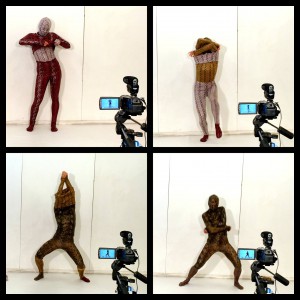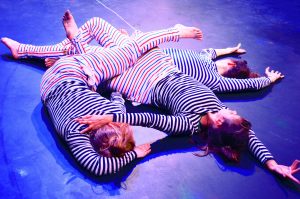Lilibeth Cuenca Rasmussen
Works for Live Art Danmark
2010 “Artist’s Song” and “Manifesto” for Samtalekøkken
2013 Live Review of “Gaia” at Samtalekøkken/Wundergrund festival
2014 “Skin Stripping” for Now and Again
2017 “Mikado” at Live Art for Børn at S/H, Copenhagen
Artist’s Song/Manifesto
For Samtalekøkken, October 2010, she performed “Artists Song” and “Manifesto”. Set to enticing music and situated in the sparse light of a video projection of flashing white, neon-like lines, that move, join, and separate, Lilibeth speak-sings her thoughts about how to enter art history while questioning whether the artists already inscribed in it are important reference points.
Gaia – Live Review
Lilibeth’s series of site specific performances titled “Gaia” examines the body’s identification in relation to the ground on which it happens to be situated, taking her own body and history as a starting point. It was reviewed live by Søren Schauser at a special edition of Samtalekøkken for Wundergrund festival.
Skin Stripping
For our project on performance for video, Now and Again, she produced the video “Skin stripping”. The artist is seen, stripping of layers of clothes, patterns and colors, meant to be read as metaphors for skin, identities and ethnicities. The full video, originally presented on an iPad during the exhibition at the Photographic Center, can be seen here, on the artist’s website.
Mikado
For Live Art for Børn S/H she showed her performance Mikado for the first time in Denmark. The intention of the participatory piece is to activate the audience, make them collaborate, play, interact and perform with each other and the dancers. The audience is divided in two teams and invited to compete with each other in a game of Mikado – only the sticks have been replaced with dancers. The game is about dancing and gathering points for your team.
About the Artist
Lilibeth’s practice is based in performance art, and sometimes transformed into different materials and media, such as video, photography, sculpture and installation. Her productions involve the body, scripted texts, songs; composed music as well as intricate visual elements like costumes used as set design. She gathers, adapts, and universalizes her narratives in both a critical and humorous approach in regards to issues such as identity, culture, religion, gender and social relations.



